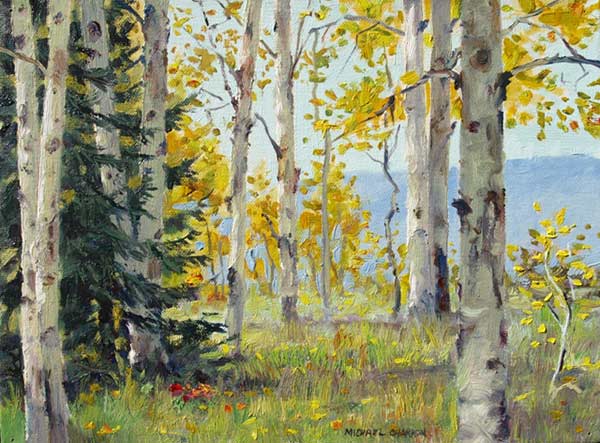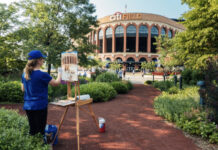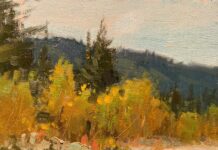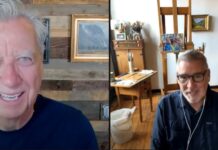Most artists have their unique ways for going about their business. Colorado artist Michael Charron has a few notable ones involving llamas, a syndication system for selling paintings, and underdrawings with spiritual symbols and cursive writing.
Charron didn’t always focus exclusively on fine art. He used to be a hockey player. And a bowhunter. But he hung up his skates at age 48 and gave up bowhunting when it became apparent that the hunting season and the plein air painting season were in direct and perfect conflict in the highest reaches of the Mount Zirkel Wilderness. The snow doesn’t completely stop up there until almost mid-July, and it starts again by the end of August. Charron takes backcountry trips in the most rugged reaches of the mountains for up to eight weeks. He carries painting gear, not archery equipment. He comes back down the mountain with at least 32 paintings.


Thanks to llamas.
Why llamas? “I take 350 pounds of gear,” says Charron. “My base camp is at 11,500 feet, and then I go further with a smaller camp. Llamas can’t carry a person, but you can stake a llama to the ground with a nylon leash like a dog and it will graze off the natural environment. I give them water about every two days, but they can go 10 days without it. Llamas are so much less maintenance than horses. Horses mean you have to take food in for them, some grain or hay. They are large animals, too. If they get nutty, you can get hurt. It takes a lot more work to transport them as well. They are heavier, which means more gas expense, and I can get several llamas in one trailer. Donkeys are unpredictable, and goats will follow you wearing a pack, but if they see someone else on the trail, they will follow them instead.

“You can’t ride llamas, but frankly, I’m from Detroit. We didn’t do a lot of horseback riding, growing up in Detroit.”
Charron has four llamas, and he leaves two at the base camp and trudges further with the remaining two, eventually continuing on where even llamas can’t go, with an 80-pound pack on his back, up countryside that is so punishing, it takes five hours to go a mile and a quarter. In the end, he gets paintings that are bracing and crackling with life. Charron says these extended, intense trips are spiritual journeys, the kind humans with a close connection with the outdoors have benefitted from for millennia.

“When you’re out there, the spiritual questions come,” he says. “Why are we here? Out in the woods, you have to face yourself. Another thing is, you sleep lighter. You don’t get into deep sleeps, because you know there are grizzlies and dangers out there. So you have a lot of dreams that are very powerful and real. I spend a lot of time in contemplative states while I am on these trips. I’ve seen such incredible stuff — simple, but incredible. The plein air painting trips are similar to hunting elk or deer — you are seeking an elusive, ethereal, magical thing, whether it’s an elk or a painting.”
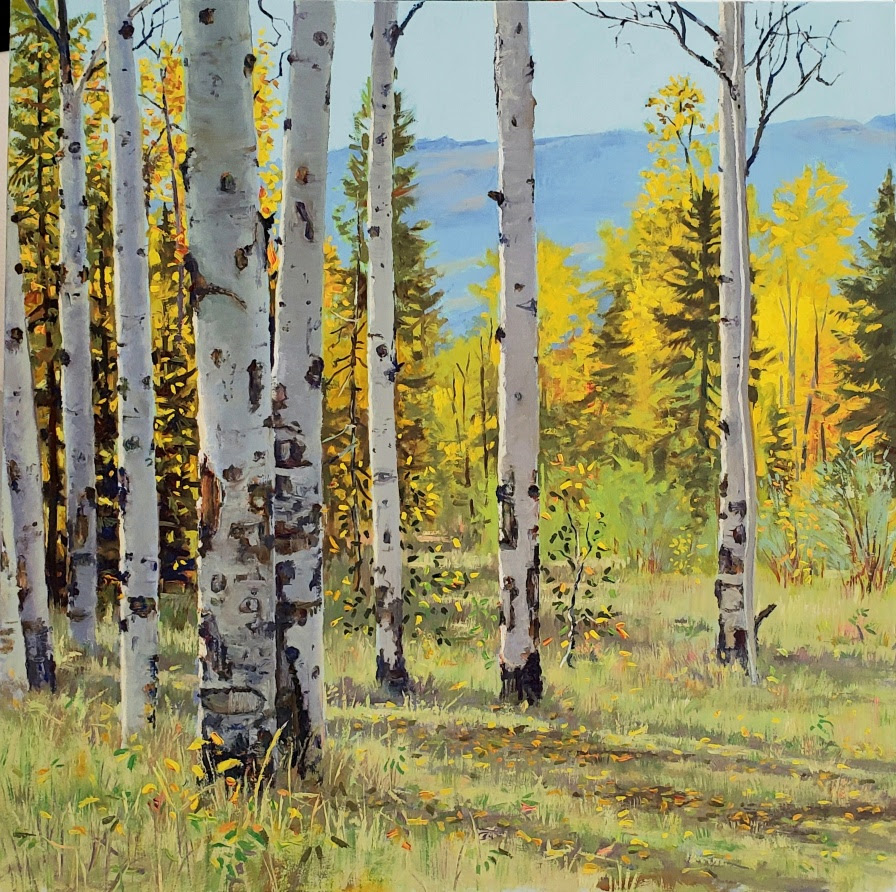
This kind of mystical experience is expected and welcomed by Charron. He reports that he has always been a seeker. That hasn’t always gone perfectly — he’s abused substances in his quests. But now the wilderness is his guide. Charron prepares for his paintings by writing affirmations on the blank canvas using oil sticks. He writes in cursive, for several reasons, including the fact that the lines are smoother and more flowing, which keeps them from disrupting further paint applications, and because he sees cursive handwriting as a dying art, one that further roots the paintings in this specific era.
Charron sees the world changing rapidly, and anticipates the day when wilderness areas are developed or, more likely, closed off from the public to protect them. He says he feels that he may be capturing some of the last on-location paintings of these areas. “The population of Colorado is starting to impinge the wilderness areas,” says Charron. “I can see a time when people aren’t allowed to go in there anymore. I can understand why. I’ve seen unbelievable stuff, very poor stewardship of nature. I am documenting these areas in that sense. I also have a very deep spiritual belief, and I’m using my art for that purpose as well.”
The underdrawings on the canvases feature religious symbols from various faith traditions — “archetypal but stylized” — and phrases and musings from Charron’s contemplations. (They generally aren’t visible in the finished painting.) He says that he usually has a theme that stretches over an entire trip, with various explorations within it. He writes at night in his camp, seeking and exploring further.

And then, when Charron returns home, he convenes the syndicate.
Charron realized he couldn’t afford these expensive, intensive trips on his own. So he set up a syndicate in which collectors underwrite his expeditions in exchange for down payments on prospective paintings. Charron guarantees that he will provide at least 32 paintings for the collectors to choose from, and then they draw numbers to see who picks first. If a collector really wants a painting already chosen, Charron will paint another version the same size or bigger for them. He’s done this for 10 years, and he has sold out of his paintings every year. “People started buying my pictures, and it just got deeper and deeper,” he says. “I can’t afford to do it on my own. It’s worked so well. I’ve never had anyone fight over a painting or be dissatisfied with the result of the draft. And in my contract I tell them if they are not satisfied, they can get their money back, but not for three months. It’s never happened.”
He heads out in July with his four llamas loaded with panniers full of V8 juice, camping equipment, canvases, and courage. He comes back with 45 or more paintings, which he edits down to present the best work to his partners in the syndicate.


“I am not a tree-hugger by any stretch of the imagination, but I think people are moving away from the natural world,” he says. Instead, Charron has labeled himself a practical mystic. One who finds himself in the wilderness.
View Michael Charron’s work in person at the upcoming exhibition “Wilderness, Serpents & Saints: An Artist’s Odyssey,” November 5-30, 2020 at the Pine Street Church Gallery in Boulder, Colorado. (Artist reception November 12, 4:00 – 8:00pm)
> Click here to subscribe to the free newsletter, Plein Air Today
> And click here to subscribe to PleinAir Magazine so you never miss an issue!

